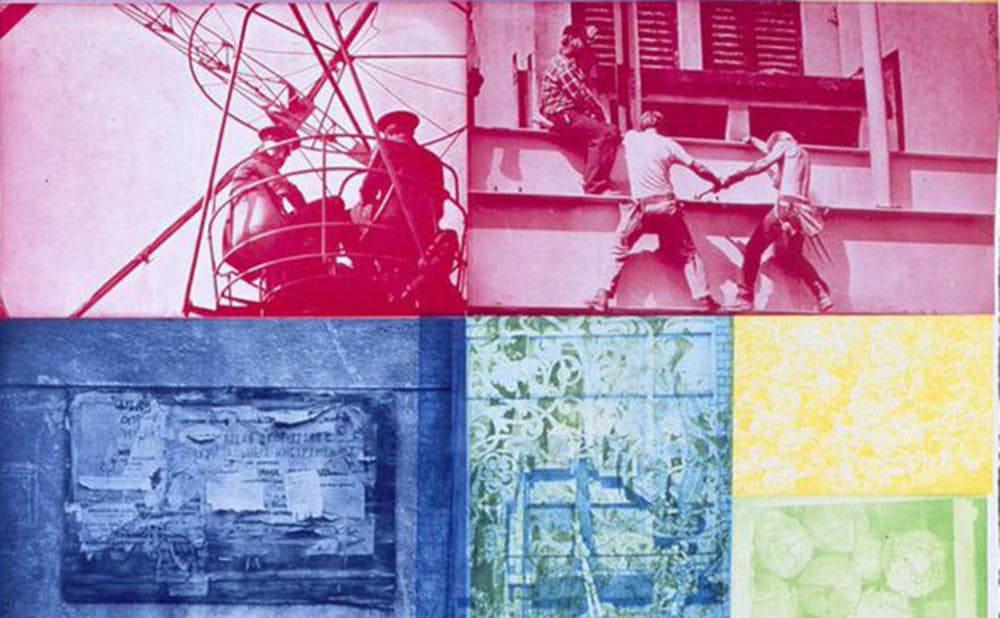An extremely prolific artist who created works in a wide range of media from printmaking to sculpture, American artist Robert Rauschenberg (1925-2008) created art over the course of 60 years. Most people know Rauschenberg exclusively from his “Combines,” which he began in 1954. Rauschenberg: Collecting & Connecting at the Nasher Museum of Art aims to show the public a more comprehensive range of Rauschenberg's work.
“The show shows that the Rauschenberg we knew is just a portion of him, and now we get the opportunity to see much more,” said Kristine Stiles, France Family Professor of Art, Art History & Visual Studies at Duke University, who curated the exhibit.
"Rauschenberg is the guest of honor, but this is a conversation around the table,” said Stiles. The show is about Rauschenberg’s works in conversation with those of other artists and in conversation with the viewer.
“Painting relates to both art and life. Neither can be made. (I try to act in that gap between the two.)”-Robert Rauschenberg
Fundamentally built upon relationships—between light and shadow, between personal and public, between faith and truth—Rauschenberg’s works invite the viewer into an autobiography. However, this is not simply a story of his life. Rather, it is a story and a conversation that is fully alive and present, one that is being created as fast as it is dissolved--a conversation among his art, the viewer and the environment.
“If you just go up and look at these paintings or these sculptures as if they’re going to tell you something, they’re not. But when you see them in relationships and in conversation, then they start telling you all kinds of things; they reveal all kinds of things,” said Stiles.
Standing in front of Rauschenberg’s Audition (Carnal Clock), 1969, the viewer unwittingly finds himself standing inside the piece, the reflection of his body next to and intermingled with photographs of bed sheets, a woman’s breast and other objects. It is only when the viewer and the external environment come into contact with the piece is there a robust story capable of coming to life.
The use of a mirrored surface likewise manifests itself in Litercy (Phantom), 1991, while enabling a vastly different experience. Composed of phantom-like, white images on a reflective silver background, the images initially appear translucent and ghostly, as if not truly present. However, once the viewer stands in front of the piece, it becomes clear that the presence of the viewer adds perspective to the images, rendering them solid and real rather than mere vestiges of objects. This occurs due to the opacity of the white paint, which makes it seem as if the viewer is standing behind the signs, in effect creating a complete environment that exists both within and outside of the painting.
“Litercy…only exists fully when everything in the room is reflected in it,” said Stiles.
Besides the use of mirrors and reflection, Rauschenberg explored identity through a variety of other means, including shadows, fingerprints and text. Found in the first thematic room “Black and White (with Red),” his seven-panel White Painting done in 1951 uses light and shadow to speak of identity and the determinants of identity.
“What Rauschenberg found most interesting about his white paintings was the fact that they actually have images on them, because they capture all the shadows in the room under certain light…and what’s around the white paintings becomes their context,” said Stiles.
“Understanding is a form of blindness. Good art, I think, can never be understood.” –Robert Rauschenberg
The exhibition is composed of eight thematic rooms containing works by other artists, including Chinese contemporary artist Ai Weiwei (b. 1957), American artist Bruce Conner (1933-2008) and “unofficial” Soviet artists, in addition to the works by Rauschenberg.
As such, “each one of the themed rooms has conversation among Rauschenberg and several other artists, and those conversations are unexpected,” said Stiles.
The exhibition gives particular emphasis to the works of Conner in relation to Rauschenberg, both of whom were interested in the idea of identity. Conner’s UNTITLED D-1 (INK DRAWING MADE TO BE HUNG IN THE SUN TO DISAPPEAR OVER TIME), 1965-71, as its title expresses, was created with a black felt-tip pen on paper, of which the drawing over time nearly disappeared. A turn of the head will reveal Rauschenberg’s Page 2 (Pages), 1974, a flat, circular sheet of tan paper with a hole in its center, made when he visited a paper mill in France.
In both works is an emphasis on the process of creation and of the pure existence of the works in their respective environments. Likewise, there is a sense of finality, in which neither work can exist in the absence of their environment and in which both works are the product of their environments.
Get The Chronicle straight to your inbox
Signup for our weekly newsletter. Cancel at any time.

